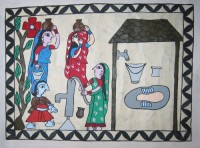The Temple of Sankata
Karunamaya was a deity born into the family of devils. A shaman, summoned to whisk the deity away from India’s Assam, knew the journey was fraught with risks. In order to ward off problems and ensure the mission’s success, the shaman conjured goddess Sankata in a pot and carried her all along, to and from Assam. On their way back, the goddess urged the shaman to place her in the vicinity of Karunamaya. Following her wish, both the deities were installed in the same temple—Sankata on the top and Karunamaya on the ground floor.
Sankata’s temple is ensconced inside a crammed but quiet Tebahal colony adjacent to the crowded and noisy New Road market. You can pass through any of the alleyways that connect the market and Tebahal colony to enter the temple area.
The premise is unfenced with the temple tucked in southern most corner of the large open square bordered by houses. Of the temple’s five gajurs, the one at the center is gilded and slightly taller than the other four. The gajurs are covered with straw mats during monsoon. The two storey temple has an overhanging roof made of copper that leans on wooden struts slanted outwards. Figures of different deities are carved on each of the struts.
Two multilayered light stands and, between them, a pillar with the life size statue of Bandhu Datta Bajracharya stands in front of the temple. Bandhu Datta Bajracharya is the shaman, summoned by King Narendra Dev, who brought and installed both the deities in the temple. While others can pray and worship, to date, only Bajracharya Newars are allowed to carry out the rites at the temple.
The front door leading into Karunamaya’s sanctum sanctorum is open only during mornings on normal days. To see goddess Sankata, on the top floor, you enter from back and climb up the wooden ladder that ends right at the door to the sacred chamber.
Skulls and smiling faces of demons carved on the frames of the door look terrifying and a sense of eeriness sweeps through your nerves when you notice three dark eyes with sparkling edges stare at you from their affixed position on the door. The eyes follow you through the circumambulatory that runs round the shrine as the framed picture hung on the walls, too, have three big eyes. The third eye is placed between and slightly above the other two (like seen on Lord Shiva’s face), except that the eyes on the frame are without a face. A pair of hands with a bowl each from left and right extends towards the unseen face, while legs hang from the mouth of two dogs at the bottom. One of the Bajracharya priests suggested that the frames represent a crematorium. Since Sankata’s rites are based on tantric principles, the presence of a crematorium becomes pertinent, even if it is in the form of a representation.
Hindus offer prayer at the temple every night of navaratra (literally, nine nights)—when nine forms of goddess Durga are worshipped. Navaratra falls in the month of October, and every year Hindus swoop in around Durga’s temples to seek her blessings. The temple of Sankata swarms with devotees at this time as the goddess is considered an avatar of Durga.
Every Saturday people wait in a long queue at the temple just to see or offer a short prayer to the goddess. When Shani (the planet Saturn) and Rahu cast their inauspicious shadows on people’s life they get mixed up with difficulties. On the day of Saturn or Shanibar, the word for Saturday in Nepali, people, particularly those under Shani’s influence, worship the goddess, as she is believed to stave off dangers from lurking near her devotees.
The word ‘Sankata’ is derived from a Sanskrit word ‘sankat’ meaning ‘plight’. Sankata, therefore, implies someone who eliminates plight. With the legend that says the goddess resolved the problems of a King and a Shaman, commoners have good reason to worship her, to keep their troubles at bay.







